Slow Cognition: The Ecological Practice Approach in Feb 2020

A window is a wonderful container because it is both open and closed. While you can view the world through a window, your perspective is framed by the window.
In August 2018, I went on my first cruise trip from Galveston to Cozumel with my family. We sailed on Carnival Dream which is a cruise ship operated by Carnival Cruise Line. At 128,250 GT, the ship is a large cruise ship with various facilities such as a water park with multiple sides, an 18-hole miniature golf course, dining venues, outdoor recreation areas, etc. It can serve 3,646 passengers.
The ship is a large container.
During the trip, I took many pictures. In Feb 2020, I used one picture of a window as a cover image of a private document. See the picture below.
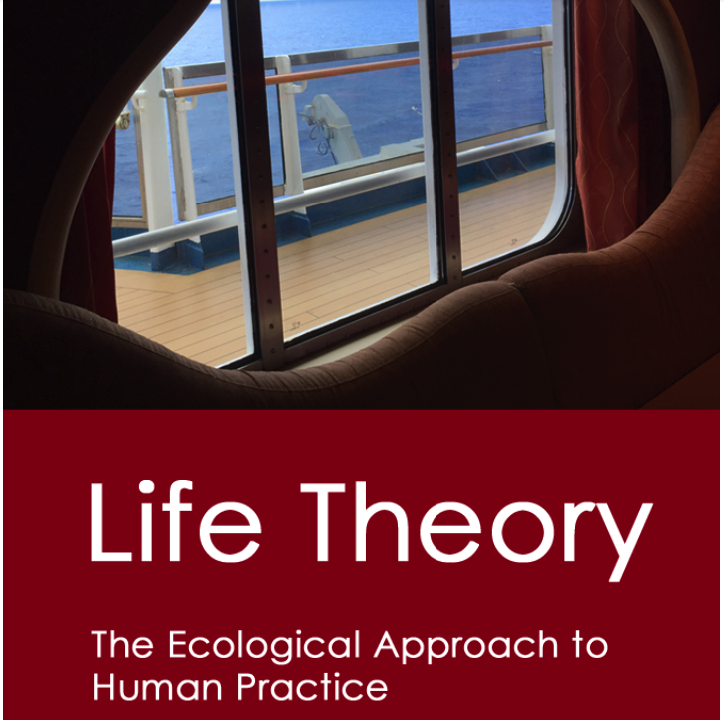
In Feb 2020, I wrote a 160-page private document titled Life Theory.
The “Life Theory” document is both a theoretical plan and a toolkit. As a theoretical plan, it describes the position and the direction of expanding the Ecological Practice approach to a social theory. As a toolkit, it curates six frameworks together. It is the beta version of the Ecological Practice approach.
Today I'd like to use it to conduct a case study of the Slow Cognition Project.
The Slow Cognition Project is a window to the past of our minds.
A Brief of the Ecological Practice Approach
From Sept 2018 to March 2019, I wrote a book titled Curativity: The Ecological Approach to Curatorial Practice in order to reflect on one of my life themes: Curation. During the process of writing, I developed a new theoretical approach called the Ecological Practice Approach which aims to build an Affordance-based theory of action and apply ideas of ecological psychology for analyzing various social practices.
After March 2019, I continuously worked on revising Curativity and developing the Ecological Practice Approach as a new project. In July 2020, I wrote another book titled After Affordance: The Ecological Approach to Human Action in which I proposed several new theoretical ideas for expanding ecological psychology to the modern digital environment.
My work is inspired by James J. Gibson’s Ecological Psychology, Roger Barker’s Behavior Settings Theory, Urie Bronfenbrenner’s Ecology of Human Development, and practice theories.
There are two goals behind the Ecological Practice approach:
- 1) Expanding Ecological Psychology from the native natural environments to the modern digital environments.
- 2) Expanding Ecological Psychology from perception-centered psychological analysis to social practice analysis.
A major development of the Ecological Practice approach is the concept of Supportance. I have been searching for a concept for expanding Ecological Psychology from perception-centered psychological analysis to social practice analysis for about two years after I finished the draft of Curativity.
The concept of Supportance means the Ecological Practice approach has transformed from a curated toolkit to an original theoretical framework. This is a major milestone of the approach.
During the process of developing the Ecological Practice Approach, I have written four books which are still drafts.

- Curativity: The Ecological Approach to Curatorial Practice (2019)
- After Affordance: The Ecological Approach to Human Action (2020)
- Platform for Development: The Ecology of Adult Development in the 21st Century (2021)
- Ecological Practice Design: The Lifesystem Approach to Everyday Life Innovation (2022)
Each year I write a book and each book establishes an important theoretical concept for the Ecological Practice approach. Curativity introduces the concept of Curativity and develops the toolkit version of the approach. After Affordance introduces the concept of Attachance and develops the germ-cell version of the approach. Platform for Development introduces the concept of Supportance.
I also edited a book about the Lifesystem framework for applying the Ecological approach to design and innovation in May 2022.
You can more details on three versions of the approach in The Development of Ecological Practice Approach.
Some Milestones
The picture below shows several milestones of the project for developing the approach.
- All books are drafts, not published yet.
- The term "published" means publishing articles on Medium.com, not academic journals.
- I often wrote private documents to develop my thoughts about the approach. These private documents were shared with some friends.
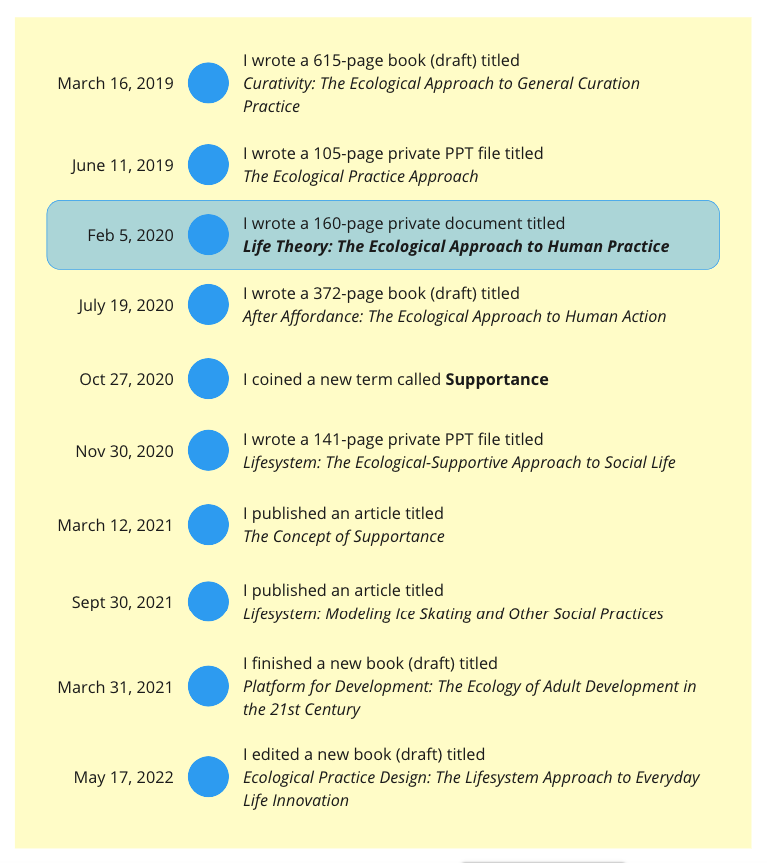
The above picture highlights the milestone of writing the "Life Theory" document.
It happened in Feb 2020 before writing the book After Affordance.
Last week, I had an opportunity to discuss the development of the approach with a mentor who is an experienced theoretical sociologist. Our discussion inspired me to re-read the "Life Theory" document.
Then, I realized that I can use it to make a public case study for the Slow Cognition Project.
Before Feb 2020
As mentioned above, I finished Curativity in March 2019. The book has eight chapters.
- Preface: Once Upon A Curator
- Chapter 1: What’s Curation?
- Chapter 2: Turning Pieces into Meaningful Wholes
- Chapter 3: Ecological Curativity Theory
- Chapter 4: Curation as Practice
- Chapter 5: Practice as Curation
- Chapter 6: Principles of Curativity
- Chapter 7: Curativity Analysis
- Chapter 8: Curativity and Epistemology
- Postscript 1: The Information Architecture of Social Life
- Postscript 2: The Seed of the Ecological Practice Approach
- Appendix 1: A Typology of Affordances
- Appendix 2: A Typology of Ecological Information
Chapter 3 (Ecological Curativity Theory) focuses on building the Ecological Curativity Theory which is formed by five concepts and each concept aims to answer one significant question.
- Curatorial Affordances: Why does Curation happen? Because everything is curable from the perspective of Affordance Theory.
- Containers: Where does Curation happen? It happens within various containers because containers set boundaries for forming meaningful wholes.
- Themes of Practice: Curation is both an individual action and a social practice. How do we coordinate individual experiences and collective culture? I coined a new term called “Themes of Practice” to develop a new solution. “Themes of Practice” refers to the transformation between individual life themes and collective cultural themes.
- Curatorial Configuration: How to understand the meaningful wholes? The answer is Situated Orders which are determined by both social practices and individual perception. I use the concept of Curatorial Configuration as an umbrella concept and it refers to various academic concepts such as Cognitive Schemas, Cultural Schemas, Activity Patterns, Behavior Settings, Social Episodes, Situated Types, etc.
- Curatorial Crafting: What’s the competence of Curation? The answer is about various cognitive skills of curatorial actions such as perceiving, selecting, reflecting, connecting, organizing, presenting, etc. Though I emphasize the principle of “Everyone A Curator”, I highlight different types of situations for curating: First-order Curating, Second-order Curating, and Third-order Curating. I also discuss several related issues such as Curation and Cognition, Curation and Reflection, Curation and Expression, and Curation and Sensemaking.
Chapter 4 (Curation as Practice) aims to establish a perspective called “Curation as Practice”. I roughly review the historical development of the Practice Turn in social science and the relationship between Ecological Psychology and the Practice Turn. Finally, I use a set of theoretical concepts (see the diagram below) to develop a theoretical framework. Originally, I called it the Gibson — Lakoff — Schön approach.
You can find more details in Curativity Theory: Table of Contents and Related Articles.
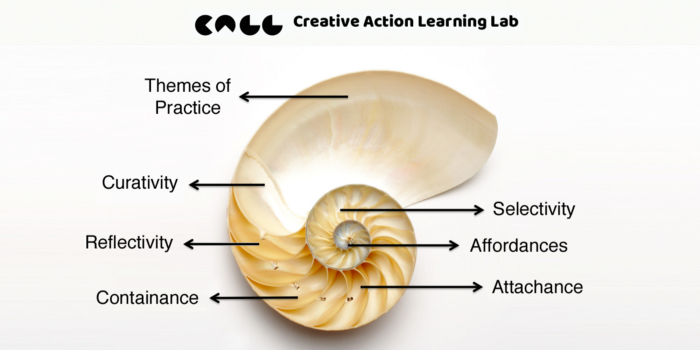
Later, I realized the Gibson — Lakoff — Schön approach can be seen as a new approach to practice studies. Thus, I renamed it the Ecological Practice approach.
In a broad sense, the Ecological Practice approach has its philosophical roots in traditional Pragmatism and contemporary embodied cognitive science. Inspired by practice studies theorist Davide Nicolini (2013)’s “tool-kit approach” which curates various concepts from different theoretical accounts based on a family relationship, allowing a network of dissimilarities and similarities, I consider the Ecological Practice approach a toolkit.
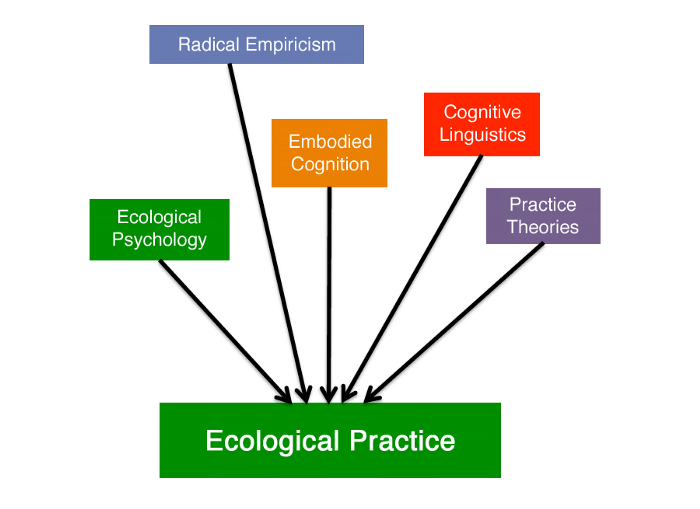
I didn't intend to develop a new theoretical approach to social practice. The Ecological Practice Approach was a by-product of my journey of reflection on the curation theme.
In the summer of 2019, I started a project and worked on the Ecological Practice Approach. I wrote a 105-page PPT file about it. One part of the file is comparing it with several popular social practice approaches. I also modified some concepts and frameworks of the approach due to some insights I discovered from the comparison.
In the fall of 2019, I had several discussions with some friends privately.
The "Life Theory" Document
In Jan 2020, I started working on a document titled "Life Theory".
Why did I name it "Life Theory"?
I used terms such as "Lifemove", "Lifeway", and "Lifeform" for a framework of the Ecological Practice Approach.
I consider the Ecological Practice Approach a meta-theory and the "Life Theory" integrated framework is a framework for social practices.
It also echoes the concept of “Activity” from Activity Theory. According to Victor Kaptelinin and Bonnie A. Nardi, the founder of Activity Theory considered Life as the name of his theory.
Leontiev’s ambition was to translate this general statement into a concrete description of how the first phenomena that can be called “psyche” emerged in history, and how they developed into the current variety of mental phenomena.
To accomplish this goal Leontiev needed a special kind of analytical tool, a concept more general than psyche, that would make it possible to define the context in which the psyche emerges and develops.
An obvious candidate for such a concept is “Life”, since ultimately this is what undergoes evolutionary change. However, this concept is too general and too vague. “Activity,” as we will see below, was chosen by Leontiev as a concept that can provide a more concrete insight into what “Life” is.(Acting with Technology: Activity Theory and Interaction Design, p.51–52)
There are at least three ways to understand the concept of “Life”.
- Life as Organism: this is the perspective of biological theories.
- Life as Practice: this is the perspective of social theories.
- Life as Ideal Type: this is the perspective of humanities.
One thing I learned from writing the "Life Theory" document is my view on the term "Practice".
Before Feb 2020, I followed the "Practice Turn" and adopted the "Practice" as the unit of analysis. However, I changed my mind after reviewing the above three dimensions of the concept of "Life".
The "Practice Turn" term only considers the perspective of "Life as Practice". For example, Theodore R. Schatzki’s Site Ontology.
According to Theodore R. Schatzki, “Social ontology concerns the nature of the social. It addresses such questions as, What is sociality? In and of what does the social consist? and What are the basic structures of social life? The broad front of individualism has historically played a dominant role in this domain. Not only has a weighty line of theorists defended individualist accounts of social phenomena, but those defending alternatives have had to define themselves against individualism. This dominance allows a division of social ontologies into two camps: individualism and nonindividualism.”
Theodore R. Schatzki suggested a third view that emphasizes the site of the social life, “ To advocate a site ontology is to claim that the character and transformation of social life are inherently tied to the site of the social. Site ontologies represent a distinct approach to social ontology…Site ontologies proceed differently. Addressing the nature of the social involves identifying the type of site where social life exists and develops. Since a site, as noted, is a kind of context, the focus is on a special type of context, not wholes, sui generis realities, or abstract structures.”
Theodore R. Schatzki’s Site is similar to my concept of Container. However, the Site Ontology is a flat ontology. According to Loscher, Spitter and Seidl, “Similar to all theories of social practice, Schatzki’s site ontology is based on the presumption that all social phenomena are rooted in practices (Schatzki, 1996). Yet, in contrast to other practice theorists, such as Bourdieu and Giddens, Schatzki assumes that there is only one single level of social reality: the level of social practices (Seidl & Whittington, 2014). This means that Schatzki‘s practice theory is based on a ‘flat ontology’, which does away with the common idea that there are different levels of reality: micro and macro levels, for example (Schatzki, 2011)”.
I reviewed the "Practice Turn" movement in the Life Theory document and rejected Theodore R. Schatzki’s Site Ontology.
Inspired by the historical development of the Internet, I considered the Site — App switch as a metaphor for a paradigm shift. In the age of Web1.0, websites are a significant element. However, the mobile internet relies on mobile apps. The major shift between the two paradigms is the relationship between devices and users. The PC paradigm requires people to follow devices while the mobile paradigm allows devices to follow people.
If we apply the Site-App metaphor to the social ontology, then the new paradigm after the Site ontology should be the App ontology which allows actors to attach to a site and detach from the site. The App ontology gives more possible opportunities to actors while remaining the reality of containers.
I used the diagram below to develop an epistemological position for the Ecological Practice Approach in the "Life Theory" document.

The above diagram represents four epistemological positions for theoretical debates. The horizontal axis of the diagram represents the Organism-Environment relationship. There are four epistemological accounts on the horizontal spectrum.
- Left: Adaptation
- Left-center: Affordance
- Right-center: Attachance
- Right: Construction
The adaptation account believes that living organisms are adapted to their environment. This view is also called environmental determinism.
The affordance account argues that organism and environment are complementary and meaning is not constructed via a subjective act but is directly available in the world as opportunities for action. Affordances are properties of the environment that relate to the organism’s capacities.
The construction account believes organisms can modify their own and each other’s niches and alter their own local environment. This view is also called Niche Construction theory.
The attachance account is similar to the affordance account. I want to highlight the agency of actors and the emergent meaning and value of actual actions while an actor is acting in his/her environment.
The difference between the affordance account and the attachance account is the former doesn’t consider the agency of actors while the latter emphasizes the agency of actors.
The difference between the attachance account and the construction account is the former works at the micro level while the latter works at the macro level.
The diagram uses a nested structure to represent micro-level analysis and macro-level analysis. The micro level is about the loop of “perception-action” while the macro level is about the loop of “nature—environment”.
By using this diagram, I found the fourth position for the Attachance perspective!
Curativity as Creativity
The major task of writing the "Life Theory" document is knowledge curation.
I used the diagram below to curate theoretical concepts and frameworks of the ecological practice approach.
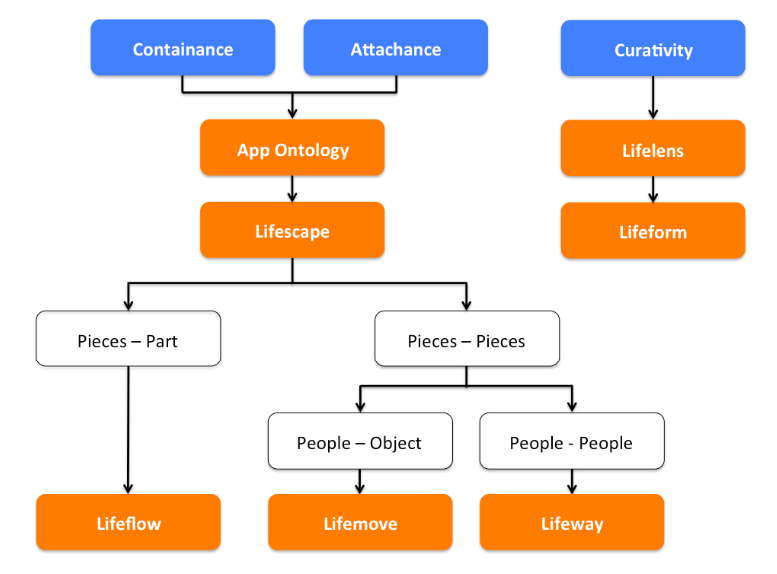
While blue items refer to theoretical concepts, orange items refer to practical frameworks.
At that time, I only developed three original theoretical concepts for the approach:
- Curativity
- Containance
- Attachance
The "Life Theory" document collected six practical frameworks. Later, I introduced some of them in After Affordance and Platform for Development.
By writing the "Life Theory" document, I curated my mind about the approach. It defined a plan of the knowledge enterprise.
The Wideness View
Now we can use the Knowledge Curation canvas to represent my thought behind the "Life Theory" document.
The Knowledge Curation Canvas is based on the following model of Knowledge Curation.

The model presents six types of “Objects of Curating” for a knowledge curation work:
- Theoretical Approaches
- Conceptual Spaces (or Conceptual Focuses)
- Practical Perspectives
- Integrated Frameworks
- Operational Heuristics
- Practical Phenomena
The Model of Knowledge Curation is used for understanding multiple-theory curation.
For single-theory curation, I use a similar diagram with different terms. You can find more details in The Knowledge Curation Toolkit #1: Theme U for Single-theory Curation.
I recently used the term "Wideness" to rename the Canvas of Knowledge Curation. See the canvas below.
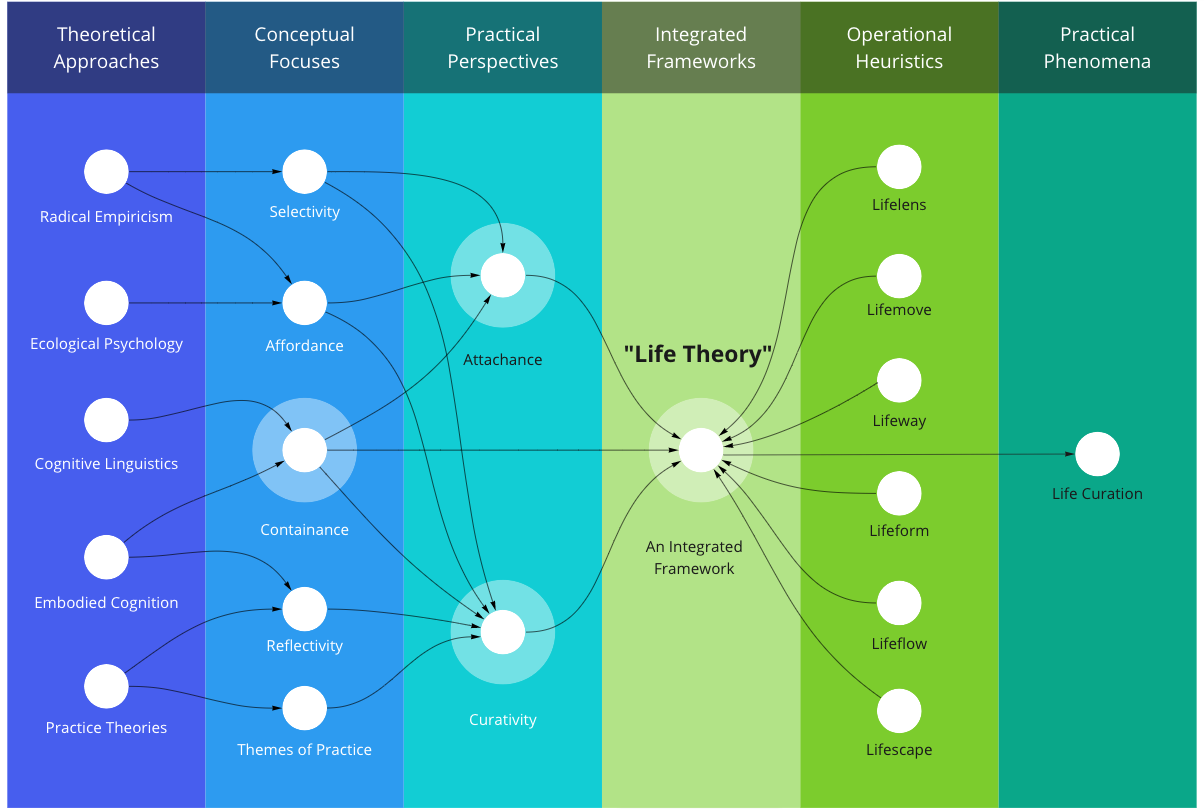
What's the approach behind the knowledge curation activity around the "Life Theory" document?
I have introduced three approaches to knowledge curation on Linkedin:
The curating of the "Life Theory" document is similar to both the Top-down approach and the Dialogue approach. It belongs to the top-down approach because it tries to apply the Ecological Practice Approach to social practices. It also can be seen as a dialogue approach because it tried to integrate six practice frameworks (operational heuristics) into an integrated framework.
Let's dive in to see some details.
The Dialogue Knowledge Curation method considers two directions of knowledge curation. The Left-to-Right direction refers to the transformation from THEORY to PRACTICE. There are two phases:
- Thematic Orientation: The Objective — Subjective Curation
- Heuristic Orientation: The Approach — Application Curation

The above Wideness canvas lists five Theoretical Approaches:
- Radical Empiricism
- Ecological Psychology
- Cognitive Linguistics
- Embodied Cognition
- Practice Theories
These five theoretical approaches have many concepts and themes, I had to pick some relevant ideas for my knowledge projects. This process is about "the Objective - Subjective Curation" which produces some Conceptual Focuses (or Thematic Spaces) as my creative focuses and thinking spaces.
Some Conceptual Focuses are named with existing concepts (such as Selectivity, Affordance, and Reflectivity), and others are named with my original terms (such as Containance and Themes of Practice).
The "Approach - Application" Curation is about connecting THEORY and PRACTICE. In the case of "Life Theory", the PRACTICE side refers to the analysis of social practices which is still a theoretical layer. However, the Ecological Practice approach is a meta-theory.
Let's return to the diagram of the "Life Theory" document. I only considered three theoretical concepts, see the blue items below.
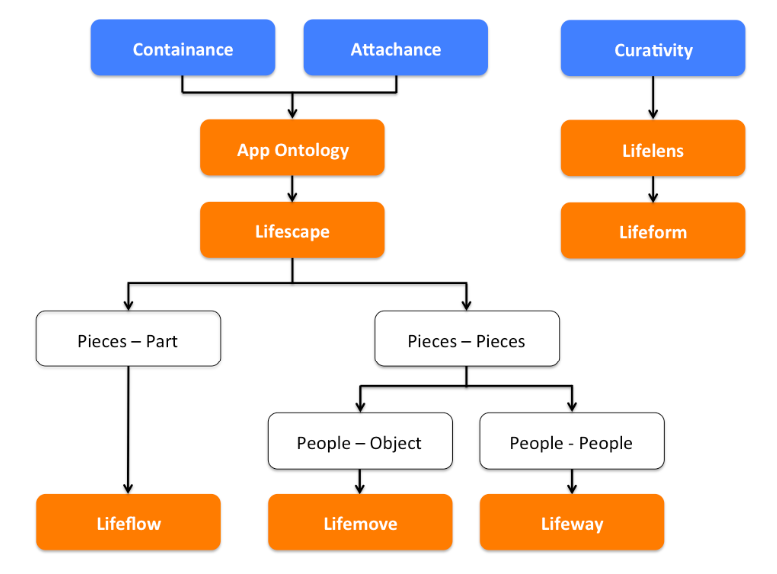
The Right-to-Left direction refers to the transformation from PRACTICE to THEORY. There are two phases too:
- Reflection: The Flow — Story Curation
- Generalization: The Story — Model Curation

For the case of "Life Theory", I didn't work with the layer of Practical Phenomena. I directly started from the layer of Operational Heuristics.
The above diagram lists six orange practical frameworks which are integrated into the "Life Theory" framework by aligning them with the three theoretical concepts.
After Feb 2020
A major milestone is discovering the concept of Supportance in Oct 2020.
Traditionally, researchers pay attention to the effect of social support on health, quality of life, and especially mental health. I aim to adopt the ecological practice approach to discuss the notion of ‘social support’ in a broader scope in a general sense.

Suppose there is only one woman and a 3-year-old girl at the scene. The woman can’t hold the picture frame because the little girl doesn’t have enough strength to help her. Thus, the woman should look for potential support from others who could offer such support with corresponding capacities.
The concept of Supportance refers to potential supportive action possibilities offered by a social environment. It is inspired by Ecological psychologist James J. Gibson’s concept of Affordance which refers to potential action possibilities offered by environments. Both two concepts are potential action possibilities. However, the concept of Affordance can be applied to both animals and humans and Gibson uses it for talking about visual perception. In order to discuss potential supportive action possibilities between a person and other people and social environments in general, I coined the term Supportance and developed it as a theoretical concept for the Ecological Practice approach.
On Feb 14, 2021, I wrote an article titled Platform, Platform-ba, and Platform Ecology and developed the "Affordance - Supportance" hierarchical loop.

The "Affordance - Supportance" hierarchical loop is the core of the ecological practice approach. It also echoes the Lifesystem framework.

I didn't publicly share all six practice frameworks I curated in the "Life Theory" document. However, you can see "Lifeform" and "Lifeway" in the Lifesystem framework.
Related Articles
- Mapping Thematic Space #6: The “Life” thematic space
- The Development of Ecological Practice Approach
- The Ecological Practice Approach Toolkit
- Ecological Practice Design (Book)
- Curativity Theory: The Ecological Approach to General Curation Practice
- Curativity Theory: Table of Contents and Related Articles
- D as Diagramming: The Attachance Perspective
- The Diagramming as Practice Framework
- The Concept of Supportance
- Platform, Platform-ba, and Platform Ecology
- Lifesystem: Modeling Ice Skating and Other Social Practices
